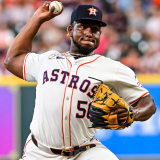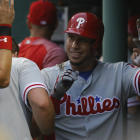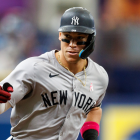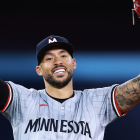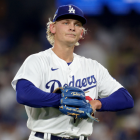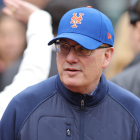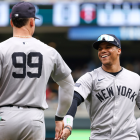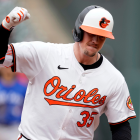It's August, and just like we're now positive the New York Mets' 11-1 start was the biggest sham of the 2018 MLB season, we're also well past the point of pretending the Philadelphia Phillies are anything but playoff material.
The days of fans prematurely condemning first-year manager Gabe Kapler are long gone. Rotation ace Aaron Nola is still squarely in the mix for NL Cy Young honors. And barring a 76ers-level tank job, the Phils are going to eclipse their 2017 win total (66) in the next few weeks -- which means they're a full two months ahead of their predecessors. This is a first-place team that, judging by the way the Atlanta Braves and Washington Nationals have performed of late, needs just a reasonably competent finish to ensure its first postseason berth since 2011.
"Reasonably competent" isn't what the team is shooting for now that it's blossoming a year ahead of schedule, though, and that's what brings us to this week's trade deadline. The Phillies were already surprisingly steady thanks to Nola, Odubel Herrera's blazing spring, the long-ball flash of Rhys Hoskins and even some incredibly timely slumps between their own batters. But they didn't sit pat in the days leading up to July 31, first landing Asdrubal Cabrera from those rival Mets and then adding Wilson Ramos from the Tampa Bay Rays.
Unlike Cabrera's old team, which decided that building around a bunch of 2011 All-Stars was a good plan in 2018, the Phillies aren't just adding names to their roster, either. Without sacrificing the farm or their payroll for what could even be an even bigger splurge come wintertime, they assembled a lineup that figures to look something like this for the stretch run:
- 2B Cesar Hernandez: 8 home runs, 35 RBI
- LF Rhys Hoskins: 21 home runs, 70 RBI
- CF Odubel Herrera: 19 home runs, 58 RBI
- 1B Carlos Santana: 16 home runs, 63 RBI
- SS Asdrubal Cabrera: 18 home runs, 58 RBI
- 3B Maikel Franco: 17 home runs, 53 RBI
- C Wilson Ramos: 14 home runs, 53 RBI
- RF Nick Williams: 14 home runs, 39 RBI
If that seems like a lot of production for one lineup, that's because it is. There were four players with at least .800 OPS marks traded in July, per NBC Sports Philadelphia's Corey Seidman, and the Phillies got two of them -- Cabrera and Ramos. After adding the latter on deadline day, Philadelphia is now the only team in all of baseball with seven different players who have at least 14 homers and 39 RBI.
Williams' 14-homer and 39-RBI marks rank roughly 100th and 135th in MLB through four months of the 2018 season. Now if those top-100 and top-135 leaderboards had perfect parity among the league's 30 teams, each team would have 3.3 players among the top 100 HR leaders and 4.5 players among the top 135 RBI leaders. The Phillies (in real life) have 7 players in both.
In other words, they own one of MLB's best lineups purely in terms of run production.
Not even the MLB-best Red Sox, who are more than 40 games over .500 with a league-high 546 RBI, match that kind of firepower on paper. Entering August, they had only five players with at least 14 homers. As for the rest of baseball's top five offenses, the Indians (four players with 14-plus homers), Yankees (six), Astros (three) and Cubs (three) also boasted fewer batters with those marks.
Before the arrival of Cabrera and Ramos, the Phils still ranked among MLB's most balanced offenses, eclipsing one-star lineups like that of the Mike Trout-fueled Los Angeles Angels, and yet somehow they still ranked outside of the top 15 in total runs and RBI. That was mostly because of a twofold Achilles heel: 1. Below-average on-base percentage and 2. A porous bench.
Now guess the areas in which Philly absolutely stands to improve thanks directly to the additions of Cabrera and Ramos. (If you guessed on-base percentage and the bench, you win.)
A staple of Tampa Bay's offense, Ramos may remain on the disabled list until as late as September, but outside of maybe Herrera, he should instantly become the best hit-for-average starter in the Phils' lineup once he hits the field for the playoff push. That's a marked upgrade at catcher, where Jorge Alfaro and Andrew Knapp have combined to hit fewer homers, fewer RBI and strike out roughly 100 more times. Cabrera, meanwhile, has just a decent .272 average, but consider his OBP (.323) vs. that of Scott Kingery (.270), who's flashed versatility but was otherwise the glaringly over-matched link of the lineup.
Not only do Cabrera and Ramos add proven bats to a group already populated with homegrown run producers, but they also ensure the raw talents of Kingery, Alfaro and/or rehabbing shortstop J.P. Crawford will be smartly confined to reserve roles, thus aiding the team's long-haul OBP outlook and revamping the bench in the process. And the flexibility of it all makes it doubly attractive. Want Cabrera at second for a night? You've got Hernandez on the bench. Want to play a series with Kingery, Alfaro and the lineup that got the Phillies to first place? You've got Ramos and Cabrera waiting in relief instead of guys like Jesmuel Valentin.
To put it simply, the Phillies bettered their offense about as best they could without completely selling out for a rental -- and probably surrendering one of their own stars-in-the-making.
Now couple that with the fact that:
- Nola (2.35) and Jake Arrieta (3.32) both rank in the top 15 for starting-pitcher earned run average in the NL
- The team's pitching staff as a whole ranks ninth in ERA (3.85) and fifth in strikeouts (963) in all of MLB
- The Phillies are an MLB-best 20-10 in one-run games and the third best vs. teams above .500 (34-28)
And you can see why the club sought deadline help in the first place. Staying out of the NL East cellar is no longer the goal. Whether you like it or not, these Phillies look like the real deal, and they obviously believe that.








